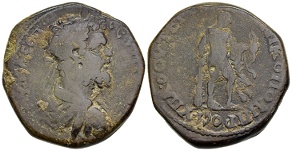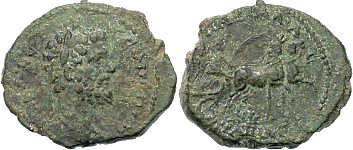Fine Coins Showcase
Antiquities Showcase
Show Empty Categories
Shop Search
Shopping Cart
My FORVM
Contact Us
About Forum
Shopping at Forum
Our Guarantee
Payment Options
Shipping Options & Fees
Privacy & Security
Forum Staff
Selling Your Coins
Identifying Your Coin
FAQs
zoom.asp
Home ▸ Catalog ▸ |Roman Coins| ▸ |The Severan Period| ▸ |Septimius Severus||View Options:   | | | | | | Septimius Severus, a native of Leptis Magna, Africa was proclaimed emperor by his troops after the murder of Pertinax. He is at the same time credited with strengthening and reviving an empire facing imminent decline and, through the same policies that saved it, causing its eventual fall. Severus eliminated the dangerous praetorians, unified the empire after turmoil and civil war, strengthened the army, defeated Rome's most powerful enemy, and founded a successful dynasty. His pay increases for the army, however, established a severe burden on Rome. Future emperors were expected to increase pay as well. These raises resulted in ever-increasing taxes that damaged the economy. Some historians believe high taxes, initiated by Severus policies, played a significant role in Rome's long-term decline. In 208 A.D., he traveled to Britain to defeat a disastrous barbarian invasion. He died in York in 211 A.D and was succeeded by his sons, Caracalla and Geta. |


In 198 A.D. Septimius Severus' oldest son Caracalla was made Augustus and his youngest son Geta received the title of Caesar.RS115080. Silver denarius, RIC IV 120c; RSC III 694; BMCRE V p. 62, 259; Hunter III 27; cf. SRCV 6370 (Laodicea), gF, flow lines, tight flan, a little off center, mild die wear, weight 2.769 g, maximum diameter 17.1 mm, die axis 0o, Rome mint, 198 A.D.; obverse L SEPT SEV PERT AVG IMP X, laureate head right; reverse VICT AVGG COS II P P, Victory walking left, wreath in right hand, palm frond in left hand; from the estate of Curtis D. Barker, ex Littleton Coin Company;
Septimius Severus, 9 April 193 - 4 February 211 A.D., Thessalonika, Macedonia



This type normally has Nike left, but we do know of two specimens from auctions with Nike right, struck with the same dies. Under Commodus the same type was struck with Nike right. Perhaps this a mule struck with a leftover die.RP113162. Bronze AE 27, Touratsoglou 13 (V5/-) var. (Nike left), SNG ANS 855 var. (Nike left), Varbanov 4343 var. (same), SNG Cop -, Moushmov -, F, green patina, red-brown areas of corrosion, part of reverse leg. obscure/weak, weight 10.776 g, maximum diameter 26.7 mm, die axis 180o, Thessalonica (Salonika, Greece) mint, emission 2, 9 Apr 193 - 4 Feb 211 A.D.; obverse AV K Λ CEΠ CEYHPOC ΠE, laureate, draped and cuirassed bust right, seen from behind; reverse ΘECCEAΛ-ONIKEΩN (clockwise from upper right), Nike (Victory) advancing right, raising wreath in extended right hand, palm frond in left hand over left shoulder; ex Numismatik Naumann auction 130 (2 Jul 2023), lot 1244 (part of); first specimen of this type handled by FORVM, Coin Archives records only two specimens of the type at auction in the last two decades; very rare with Nike right;
Septimius Severus, 9 April 193 - 4 February 211 A.D., Nikopolis ad Istrum, Moesia Inferior


The first of Herakles' twelve labors, set by his cousin King Eurystheus, was to slay the Nemean lion and bring back its skin. It could not be killed with mortal weapons because its golden fur was impervious to attack. Its claws were sharper than swords and could cut through any armor. Herakles stunned the beast with his club and, using his immense strength, strangled it to death. During the fight, the lion bit off one of his fingers. After slaying the lion, he tried to skin it with a knife but failed. Wise Athena, noticing the hero's plight, told him to use one of the lion's own claws to skin the pelt.RP112135. Bronze assarion, H-H-J Nikopolis 8.14.14.5 (R4), AMNG I/I 1276, Moushmov 1009, Varbanov 2769 (R4), SNG Cop -, F, dark brown patina, earthen deposits, scratches, central depressions, weight 11.976 g, maximum diameter 25.0 mm, die axis 225o, Nicopolis ad Istrum (Nikyup, Bulgaria) mint, magistrate Ovinius Tertullus, 198 - 201 A.D.; obverse AV·K·Λ·CEΠ· - CEVHPOC Π, laureate, draped, and cuirassed bust right, seen from behind; reverse YΠA OOV TEPTVLLOV NIKOΠOΛI ΠPOC I, Herakles standing slightly right, nude, leaning on grounded club in right hand, patera in left hand, Nemean lion draped over left arm; from Shawn Caza, former diplomat, author of A Handbook of Late Roman Coins (Spink, 2021), collection assembled during postings and international travel; ex Dorotheum Vienna;
Septimius Severus, 9 April 193 - 4 February 211 A.D., Laodiceia ad Mare, Seleucis and Pieria, Syria


Laodiceia was made a metropolis in 194 and a colonia with ius Italicum in 197/8 A.D.RP113185. Bronze AE 27, Meyer Laodikeia 10 (same rev. die); SNG Cop 362 (same c/ms); BMC Galatia p. 258, 84; Lindgren 2088; c/ms: Howgego 581 (CA), Howgego 586 (COL), gF, desert patina with highlighting earthen deposits, edge cracks, weight 9.525 g, maximum diameter 27.2 mm, die axis 0o, Laodicea ad Mare (Latakia, Syria) mint, obverse AYT KAI CEΠ CEOYHPOC, laureate head right, countermarks: CA and COL each in rectangular punch; reverse IOYΛ / ΛAOΔIC/EOYH / M/HTPOΠO/ΛEΩC (MH ligate) in five lines within laurel wreath; from the Michael Arslan Collection;
Septimius Severus, 9 April 193 - 4 February 211 A.D., Bagis, Lydia


Inscriptions uncovered by Keppel place ancient Bagis near Sirghe on the left (south) side of the Hermos River. Modern scholars pinpoint a site at Güre, Usak Province, Turkey. The "Treasures of Croesus" findings from Lydian tumuli around the town were plundered in the 1960s but recovered by the 2000s and now in the Usak Museum.RP110155. Bronze AE 25, GRPC Lydia II 65 var. (legends); BMC Lydia p. 36, 26 (same); SNG Cop 48 var. (same); SNGvA -, SNG München -, VF, centered, cleaning a bit rough with marks and bare metal high points, weight 7.994 g, maximum diameter 25.2 mm, die axis 180o, Bagis (Güre, Turkey) mint, Archon Antigonus; obverse AY KA Λ CE CEOVHPO, Laureate, draped and cuirassed bust right; reverse EΠI ANTIΓ B AP - A TO B BAΓHNΩ (HN ligate), Zeus Lydios standing slightly left, head left, eagle in right hand, scepter in left hand; unpublished legend variety;


Certificate of Authenticity issued by David R. Sear.SH58612. Gold aureus, RIC IV 237; Calico 2517 (same dies); BMCRE V p. 361, 23 & pl. 53, 13 (same obv die); S 6229, aVF, weight 7.240 g, maximum diameter 20.4 mm, die axis 180o, Rome mint, c. 210 A.D.; obverse SEVERVS PIVS AVG, laureate head right; reverse P M TR P XVIII COS III P P, Victory advancing right, head left, leading captive with right, trophy over shoulder in left; full circle centering on both obverse and reverse, ex Forum (2008), ex Harlan Berk, very conservative Sear grade; rare; SOLD
Septimius Severus, 9 April 193 - 4 February 211 A.D., Pautalia, Thrace


The site of Pautalia (modern Kyustendil, Bulgaria) was settled in the Iron Age by the Thracian Dentheletes tribe. It was located near thermal springs and remains of the ancient city include a temple of Asklepios and Roman baths. In the 1990s, excavation of nearby 2nd century A.D. tumuli unearthed bronze surgical instruments and a small bronze case containing a variety of medicines.RP63965. Bronze AE 30, Ruzicka Pautalia 264 (same reverse die), Varbanov II 4653, SNG Cop -, BMC Thrace -, aF, smoothing, weight 26.306 g, maximum diameter 30.3 mm, die axis 180o, Pautalia (Kyustendil, Bulgaria) mint, obverse AYT K Λ CEΠTI CEYHPOC ΠEP CEB, laureate head right; reverse HΓE K AIΛIOY ONEPATOY OYΛΠIAC ΠAYTAΛIAC, tetrastyle temple seen in three-quarters perspective, no steps, Apollo-Bonus Eventus standing within, flanked by a tree left and another right; thick sestertius-like flan; rare; SOLD
Septimius Severus, 9 April 193 - 4 February 211 A.D., Pautalia, Thrace


The site of Pautalia (Kyustendil, Bulgaria) was settled in the Iron Age by the Thracian Dentheletes tribe. Strymon, son of Oceanus and Tethys, was a river god and king of Thrace. By the muses Euterpe or Calliope, he became the father of Rhesus, Brangas, and Olynthus, and by Neaera of Evadne.RP72133. Bronze tetrassaria, Moushmov 4192 (this coin on Wildwinds' Moushmov online), Varbanov 4790 (R4, refs wildwinds), Ruzicka -, SNG Cop -, SNG Hunterian -, BMC Thrace -, F, centered, somewhat weak reverse, corrosion lower reverse, weight 14.838 g, maximum diameter 29.1 mm, die axis 225o, Pautalia (Kyustendil, Bulgaria) mint, 9 Apr 193 - 4 Feb 211 A.D.; obverse AVT K Λ CEΠTI CEVHPOC ΠE, laureate head right, bare right shoulder from behind; reverse OVΛΠIAC, ΠAVTAΛIAC in exergue, river-god Strymon reclining left, nude to waist, himation around hips and legs with end draped on left arm, branch in right hand, left elbow resting on urn from which water flows; ex Henrik Agndal collection, this is the only example of the type known to Forum, but very similar types also exist; very rare; SOLD
Septimius Severus, 9 April 193 - 4 February 211 A.D., Augusta Traiana, Thrace


Hera (Juno to the Romans) is the wife and one of three sisters of Zeus in the Olympian pantheon of Greek mythology and religion. Hera's mother is Rhea and her father Cronus. Her chief function was as the goddess of women and marriage. The cow, lion and the peacock were considered sacred to her. Portrayed as majestic and solemn, often enthroned, and crowned with the kalathos. Hera was known for her jealous and vengeful nature against Zeus' lovers and offspring, but also against mortals who crossed her. Paris earned Hera's hatred by choosing Aphrodite as the most beautiful goddess.RB73700. Bronze AE 32, Schönert-Geiss MATT 117 (V49/R96); Varbanov II 1029 (R4); Mionnet supp. II p. 508, 178 var. (head); SNG Cop -, VF, dark green patina, some light corrosion, central cavities, weight 16.852 g, maximum diameter 31.8 mm, die axis 225o, Augusta Traiana (Stara Zagora, Bulgaria today) mint, hegemon Statilus Barbarus, 196 - 198 A.D.; obverse AVK Λ CEΠTIM CEVHPOC Π, laureate, draped, and cuirassed bust right, seen from behind; reverse HΓ ET BAPBAPOY AVΓOVCTHC TPAIANHC, Hera standing facing, head left, wearing kalathos and veil, patera in right hand, transverse scepter in left hand; SOLD
Septimius Severus, 9 April 193 - 4 February 211 A.D., Pautalia, Thrace


The site of Pautalia (modern Kyustendil, Bulgaria) was settled in the Iron Age by the Thracian Dentheletes tribe. It was located near thermal springs and remains of the ancient city include a temple of Asklepios and Roman baths. In the 1990s, excavation of nearby 2nd century A.D. tumuli unearthed bronze surgical instruments and a small bronze case containing a variety of medicines.RP65136. Bronze AE 25, Apparently unpublished; Ruzicka -, Varbanov II -, Moushmov -, SNG Cop -, BMC Thrace -, VF, weight 7.035 g, maximum diameter 25.6 mm, die axis 0o, Pautalia (Kyustendil, Bulgaria) mint, obverse AYT Λ CEΠ CEYHPOC ΠEP CEB, laureate head right.; reverse OVΛΠIAC ΠAVTAΛIAC, Nike in biga right, reins in right, palm frond in left; very rare; SOLD
CLICK HERE TO SEE MORE FROM THIS CATEGORY - FORVM's PRIOR SALES



OBVERSE LEGENDS
REFERENCES
Page created in 1.438 seconds.








